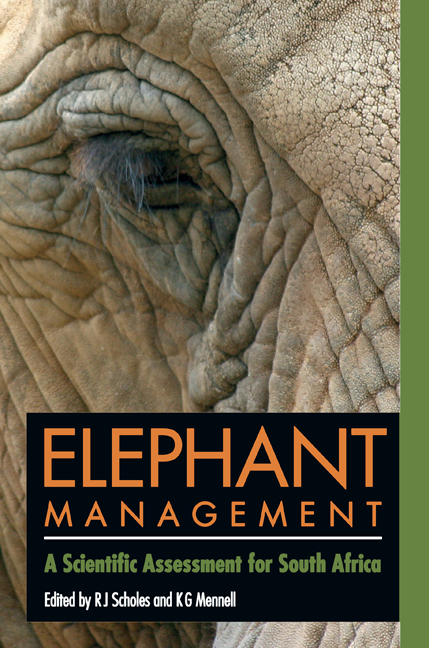Book contents
- Frontmatter
- Foreword
- Contents
- List of figures
- List of tables
- List of boxes
- About the authors and contributors
- List of reviewers
- Acronyms and abbreviations
- Preface
- Summary for policymakers
- Chapter 1 The elephant in South Africa: history and distribution
- Chapter 2 Elephant population biology and ecology
- Chapter 3 Effects of elephants on ecosystems and biodiversity
- Chapter 4 Interactions between elephants and people
- Chapter 5 Elephant translocation
- Chapter 6 Reproductive control of elephants
- Chapter 7 Controlling the distribution of elephants
- Chapter 8 Lethal management of elephants
- Chapter 9 Ethical considerations in elephant management
- Chapter 10 The economic value of elephants
- Chapter 11 National and international law
- Chapter 12 Towards integrated decision making for elephant management
- Glossary
- Index
Summary for policymakers
Published online by Cambridge University Press: 04 June 2019
- Frontmatter
- Foreword
- Contents
- List of figures
- List of tables
- List of boxes
- About the authors and contributors
- List of reviewers
- Acronyms and abbreviations
- Preface
- Summary for policymakers
- Chapter 1 The elephant in South Africa: history and distribution
- Chapter 2 Elephant population biology and ecology
- Chapter 3 Effects of elephants on ecosystems and biodiversity
- Chapter 4 Interactions between elephants and people
- Chapter 5 Elephant translocation
- Chapter 6 Reproductive control of elephants
- Chapter 7 Controlling the distribution of elephants
- Chapter 8 Lethal management of elephants
- Chapter 9 Ethical considerations in elephant management
- Chapter 10 The economic value of elephants
- Chapter 11 National and international law
- Chapter 12 Towards integrated decision making for elephant management
- Glossary
- Index
Summary
THE NATURE OF THE ISSUE
PRIOR TO European colonisation, elephants occurred virtually everywhere in the area that comprises the modern South Africa, as well as in much of the rest of sub-Saharan Africa. By the beginning of the twentieth century, elephants were in decline over most of their former African range and almost extinct in South Africa. The main causes of the decline were hunting (for ivory, hides, and meat) and loss of habitat, mainly to agriculture. The establishment of protected areas has led to a remarkable recovery in elephant numbers in South Africa, Namibia, Botswana, and Zimbabwe. Elephants remain relatively numerous in Zambia and Mozambique. In most of the rest of Africa, elephant populations are either very low (West Africa), or declined precipitously in the 1970s and 1980s and are now more or less stable (East Africa). The forest-dwelling elephants of Central Africa, almost certainly a different species, continue to decline at an alarming rate. Although the African savanna elephant is not at imminent risk of extinction (figure 1), its population trend has been, and continues to be, of international concern. Actions taken to manage elephant populations in Africa are subject to intense scrutiny and often political pressure. Legal international trade in elephant products is strictly regulated in terms of the Convention on International Trade in Endangered Species of Wild Fauna and Flora (CITES), to which South Africa is a signatory.
This assessment deals exclusively with the management of near-wild populations of the savanna-dwelling African elephant (Loxodonta africana) in South Africa. It does not deal with captive elephants. Information on the elephant populations of southern and East Africa is clearly relevant to this Assessment and has been cited, but the social and ecological conditions under which they occur differ significantly from the circumstances in South Africa. The South African situation, where elephant and human distributions are completely spatially separate, is unique.
The elephant population density (i.e. the number of elephants per square kilometre of current elephant range, for a given period of time) has risen in parts of the southern African states listed above to the point where it raises concerns regarding impacts on the environment and people. The key concerns in South Africa are the appearance and ecological functioning of the landscape, the potential impacts on other species of plants and animals, and the livelihoods and safety of people adjacent to the elephant range.
- Type
- Chapter
- Information
- Elephant ManagementA Scientific Assessment for South Africa, pp. 1 - 22Publisher: Wits University PressPrint publication year: 2008



